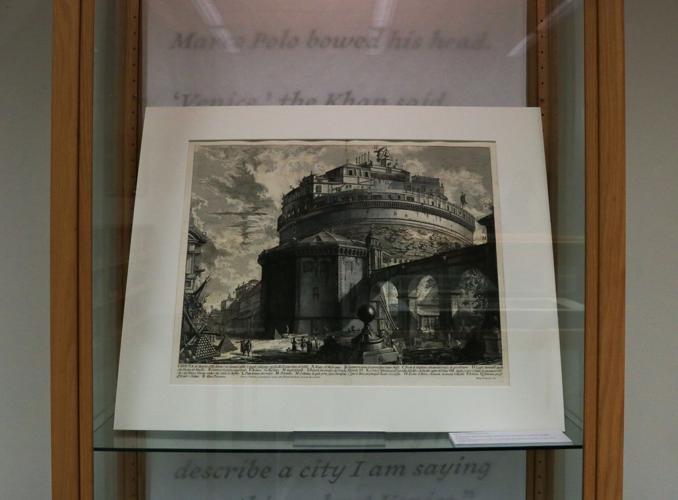At the beginning of autumn quarter, the UW Libraries Special Collections opened the exhibit “Invisible Cities: The Prints of Giovanni Battista Piranesi and the Art of the Built Environment.” The exhibit showcases a collection of the prints and work by the famous Italian architect and artist Giovanni Piranesi alongside student and faculty work from the College of Built Environments (CBE) inspired by him.
UW Libraries houses the largest library collection in the Pacific Northwest, and its Special Collections — located in the basement level of Suzzallo and Allen Libraries — features cultural and historical exhibits through mediums such as prints, photographs, manuscripts, and more.

The Invisible Cities exhibit located in the Special Collections section of the Allen Library at The University of Washington.
Exhibit curator Kat Lewis, who also works as an assistant book arts and rare books librarian, says that the engravings of Piranesi were donated by the son of famous Seattle architect and UW faculty member Carl Gould, who designed the iconic Suzzallo Library.
Gould acquired these prints on a tour in Europe and used them for teaching when he taught in the CBE, as, according to Lewis, different prints highlighted different technical fields like city planning, civil engineering, and landscape architecture.
Upon retrieval, the prints were actively worked on by the UW Libraries Conservation Center for five years, repairing mold damage and tears to prepare them for research and viewership. After they were deemed functional, Lewis, who specialized in 18th century print culture during her graduate studies, felt personally drawn to hosting an exhibit showing them off.
“How appreciative I am of the conservation team,” Lewis said. “Their diligent work on the [prints] allowed us to be able to see them, and they also helped a lot with the installation process. If it weren’t for them, this [exhibit] wouldn’t have been possible.”

An engraving created by Giovanni Battista Piranesi entitled "Veduta del Mausoleo d'Elio Adriano Cora chiamato castello S. Angelo".
Piranesi’s prints within the exhibit are of his views of Rome, known as his “passion project.” Lewis explained that Piranesi was hoping to distribute these around Italy and Europe to inspire people to reinvigorate the Italian city-state’s identity, since Italy was occupied by Napoleonic France at the time.
“His depictions show both the grandeur of what was once in Rome, and then also the contemporary city life,” Lewis said.
The title of the exhibit comes from the 1972 novel, “Invisible Cities,” by Italian writer Italo Calvino, who critiqued the dominance of modernism in architecture design rising in the 1970s. Calvino, much like Piranesi, was hoping for a more romantic view of the built environment through preserving history and tradition.
The exhibit includes text citing that Piranesi and Calvino were both “victims of nostalgia” due to their emphasis on maintaining tradition, heritage, and legacy in future innovative work.

A Gargoyle student drawing created by a UW student from 1928-1929.
This idea connects directly to the concept of preservation present in the exhibit’s modern collection. In the display of sketches from famous Seattle architects, late UW faculty member Victor Steinbrueck documented the different types of architectural features that disappeared during the construction of Interstate 5 and the Hooverville communities that were present in Seattle during the Great Depression.
The exhibit also heavily features student work through the form of student sketches and models, as both Piranesi and “Invisible Cities” are incorporated in CBE coursework, which was highly influential in understanding technical aspects of architecture. Lewis shared that this section also shows the future vision of a student working on their own “invisible city” that some day may even be visible.
“The students and the faculty that are in the school now are in the process of creating the city that we’re going to know in the future,” Lewis said.
The “Invisible Cities” exhibit is open until March 18 and is located in the basement of the Allen Library South. Schedule an appointment by visiting Special Collections’ website to view the exhibit and learn more.
Reach writer Anjali Singh at arts@dailyuw.com. Twitter: @anjali_singh35
Like what you’re reading? Support high-quality journalism by donating here.









(0) comments
Welcome to the discussion.
Log In
Keep it Clean. Please avoid obscene, vulgar, lewd, racist or sexually-oriented language.
PLEASE TURN OFF YOUR CAPS LOCK.
Don't Threaten. Threats of harming another person will not be tolerated.
Be Truthful. Don't knowingly lie about anyone or anything.
Be Nice. No racism, sexism or any sort of -ism that is degrading to another person.
Be Proactive. Use the 'Report' link on each comment to let us know of abusive posts.
Share with Us. We'd love to hear eyewitness accounts, the history behind an article.